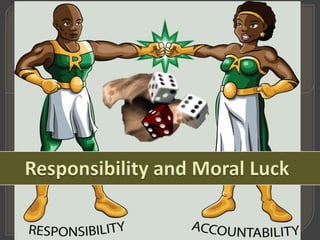
Moral Luck and Culpability
- 2. 1. Is A’s action any worse than B’s? 2. Is A more responsible for the death than B? 3. Can we judge A to be a worse person than B? 4. Should the law hold A and B equally responsible? Examples: 2 guys, equally at fault, but varying consequences. Ex: 2 drunk guys drive, unlucky driver A hits & kills a child, is arrested, charged w/drunk driving & manslaughter. Lucky driver B hit nobody, but was stopped & given a DUI. Ex: 2 hitmen aim at respective targets. Hitman A hits target, but B’s target is wearing a bullet proof vest & survives. Both arrested, A charged w/murder, B charged only w/attempted murder. Ex: 2 switchmen work for different railroads. Both were to throw a switch at 10am & both got lazy, failed to do so. Unlucky man A’s train was running & the failure to switch tracks train wreck. Lucky man B’s train had engine problems. (Acts of omission, w/consequences.) Ex: 2 firemen trying to save kids through a burning apartment windows. Man A’s child steps on window ledge which collapses due to poor construction & child dies, fireman feels guilty. Man B successfully saved the other child & is celebrated on newspaper as hero. In all 4 cases, A is unlucky & B is lucky. What makes one morally responsible & what does it have to do with luck?
- 3. Culpability = the degree to which one can be held legally or morally responsible 1. When you actually cause overall bad consequences to happen • Worse consequences = greater culpability 2. When you perform a wrong action • Worse action = greater culpability 3. When you act out of wicked intentions • Worse intentions = greater culpability
- 4. I DIDN’T KNOW! IT WAS OUT OF MY CONTROL! Ex. hidden stop sign Ex. sleepwalking, or crimes of passion
- 5. “we’re only responsible for our intentions” Circumstances external to a person should NOT influence our moral judgments of his or her character, action, blameworthiness etc. The only thing that we have complete voluntary control over are our intentions Culpability depends on our intentions. (view 2)
- 6. When are your actions morally blameworthy or praiseworthy? • When you are morally responsible for your actions. • When you exercise control over your actions Kant’s ethics assume that we are all equal rational agents participating in Thomas Nagel morality with an equal opportunity to do and be morally praiseworthy and blameworthy. This is wrong!
- 7. ① Luck in the way your actions and projects turn out ② Luck in how you have been determined by previous circumstances ③ Luck in the temperament, emotions and personality you have ④ Luck in the circumstances you find yourself in “If you’re not in control, how can you be responsible for your luck?” “The things we’re proud of & also want to blame others for are largely b/c of luck.”
- 8. From the external (objective) view we take of the world: our lives are just a series of events occurring in a world we have little or no control over. From the internal (subjective) view we take of the world: are beings who makes choices and whose lives could never be reduced to a series of events. Both of these views seem right, but incomplete. They also contradict one another and can not both be true. Together, they’re paradoxical.
- 9. Case type 1: • Harm is caused, but the agent is not at fault Case type 2: • Agent causes benefit, but does not deserve any merit for doing so. Case type 3: • The agent act negligently or recklessly (at fault), but no harm is caused.
- 10. Variables: brakes checked & kid in street Unlucky No Fault Driver Lucky Fault Driver Unlucky Fault Driver Thomson: No fault driver did not act badly Lucky fault driver acted badly Unlucky fault driver acted worse because he’s to blame for the death that he caused.
- 11. General principle: Bad consequence of an action makes that action worse only where the agent is to blame for that bad consequence which his action causes Objection from “Kantian moral sophisticate”: You can’t blame someone for something caused merely out of bad luck. Reply: • Unlucky No Fault Driver was unlucky in two ways : (1) that the child ran into his path; (2) that he couldn’t stop his truck on time. • Unlucky Fault Driver was only unlucky (1). The bad breaks were his fault. Objection: You can’t blame someone for something that involved any luck – for anything out of their control Reply: That goes too far. Sure we can!
- 12. ACTUAL CASE THOMSON’S REVISED VERSION Both Tice and Simonson fire their During the trial evidence is rifles in Summer’s direction with presented that shows Summers’ equal negligence injury came from Tice’s gun. Summers is struck in the eye and sues his two friends for damages It’s impossible to know which one harmed Summers Court decides they should split the damages equally Simonson acted badly, but is not to legally blame for the injury and should not have to pay damages Morally, however, we do not think Tice’s action worse than Simonson’s
- 13. Unlucky fault driver did something worse than lucky fault driver Tice did not do something worse than Simonson, but he is the one that must pay for the damages The difference is that Simonson nearly caused the same exact harm as Tice, but the same can not be said for the lucky fault driver
- 14. Ignore it? Embrace it? Split the difference somehow?